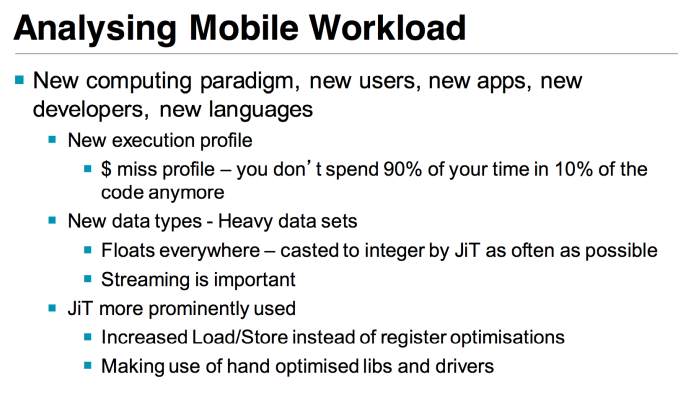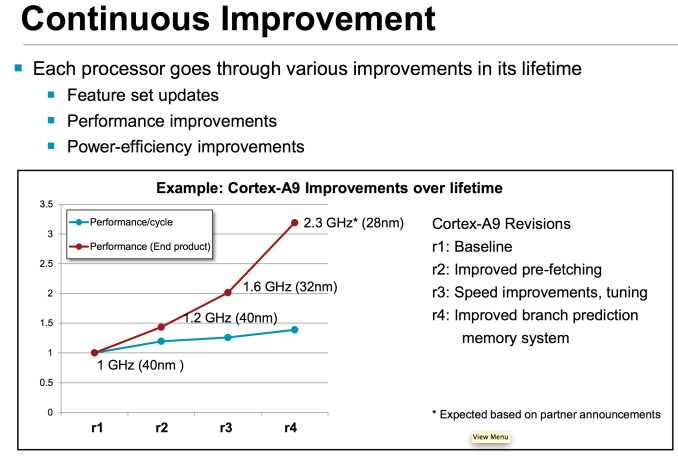The ARM Diaries, Part 2: Understanding the Cortex A12
by Anand Lal Shimpi on July 17, 2013 12:30 PM EST- Posted in
- CPUs
- Arm
- SoCs
- Cortex A12
Performance Expectations & Final Words
ARM’s Cortex A9 was first released to licensees back in 2009, with design work beginning on the core years before that. To say that the smartphone market has changed tremendously over the past several years would be an understatement. Many of the assumptions that were true at the time of the Cortex A9’s development are no longer the case. There’s far more NEON/FP code in use on mobile platforms, higher frequency of memory accesses and much heavier performance demands in general. While the Cortex A9 was a good design for its time, its weaknesses on the FP and memory fronts needed addressing. Thankfully, Cortex A12 modernizes the segment.
Although ARM referred to Cortex A9 as an out-of-order design, in reality it supported out-of-order integer execution with in-order FP and memory operations. ARM’s Cortex A12 moves to an almost completely OoO design. All aspects of the design have been improved as well. Although the Cortex A9 is expected to continue to ramp in frequency over the next year as designs transition to 28nm HPM and beyond, Cortex A12 should deliver much better performance in an more energy efficient manner.
At the same frequency (looking just at IPC), ARM expects roughly a 40% uplift in performance over Cortex A9. The power efficiency and area implications are more interesting. ARM claims that on the same process node as a Cortex A9, a Cortex A12 design should be able to deliver the same or better power efficiency. The design achieves improved power efficiency by throwing more die area at the problem; ARM expects a Cortex A12 implementation to be up to 40% larger than a Cortex A9. Just like the increasing performance of the Cortex A15 line of microarchitectures necessitates development of the Cortex A9/A12 line, the increasing size of this line drives up demand for the Cortex A7/A53 family below it.
ARM’s unique business model allows for the extreme targeting and customization of its microprocessor IP portfolio. If one of its cores gets too large (or power hungry), there’s always a smaller/more energy efficient option downstream.
The Cortex A12 IP has been finalized as of a couple of weeks ago and is now available to licensees for integration. The first designs will likely ship in silicon in a bit over a year, with the first devices implementing Cortex A12 showing up in late 2014 or early 2015. Whether or not the design will be too late once it arrives is the biggest unknown. Qualcomm’s Krait 300 core should provide the smartphone market with an alternative solution, but the question is whether or not the mobile world will need a Cortex A12 when it shows up. We always like to say that there are no bad products, just bad pricing. A more aggressively priced alternative to a Snapdragon 600 class SoC may entice some customers. Until then, the latest revision to the Cortex A9 core (r4) is expected to carry the torch for ARM. ARM also tells us that we might see more power optimized implementations of Cortex A15 in the interim as well.












65 Comments
View All Comments
haukionkannel - Wednesday, July 17, 2013 - link
I am interested in how this A12 compares to A53 in speed wise... A53 has wider registers (64 bit) but A12 run in higher freguensis and has more cores?Wilco1 - Wednesday, July 17, 2013 - link
A12 will beat A53 by about 40%: A53 delivers performance comparable to A9 and A12 is 40% faster than A9. Note that 64-bit is not relevant and certainly doesn't provide a big speedup - even on x86 almost all software is still 32-bit as there is little to gain from going to 64-bit.jwcalla - Wednesday, July 17, 2013 - link
Well this isn't entirely accurate as some of us are running almost completely pure 64-bit systems. And it does appear that video encoding and decoding are common operations that can benefit from 64-bit software from some of the benchmarks I've seen, but that might actually have been from compiler options so maybe not. But otherwise yes, the 64-bit ARM chips are only really important for server type workloads where people already have 64-bit software that they don't want to rework.Wilco1 - Wednesday, July 17, 2013 - link
64-bit has pros and cons. x64 provides more registers so some applications run faster when built for 64-bit - that may well the video codecs you mention. However there are downsides as well, as all your pointers double in size, which slows down pointer heavy code. On 64-bit ARM things will be similar.Note the main reason for 64-bit is allowing more than 4GB of memory. The latest 32-bit ARMs already support this, so for mobiles/tablets etc there is no need to change to 64-bit.
wumpus - Thursday, July 18, 2013 - link
Er, no. Just no.From what I can tell, 32 bit ARM chips use (from a developer's view) the exact same mechanism as x86 and PAE. This might use 4G of RAM efficiently (and for those OSs that like to leave all apps in RAM, it might work well for a bit more).
Trying to address more memory than an integer register can map to is always going to be an unholy kludge (although I would personally recommend all computer architects design such a system into the architecture because it *will* happen if the architecture succeeds at all). Since ARM chips tend to go into machines that rarely allow memory to be upgraded, no vendor really should be selling machines with >4G RAM and 32 bit accessing. The size/power/cost tradeoff isn't worth it
google "Support for ARM LPAE". All my links go straight to the pdfs and I wind up with all the google code inbedded in my links.
Calinou__ - Thursday, July 18, 2013 - link
PAE doesn't allow for more than 3 GB per process. ;)Wilco1 - Thursday, July 18, 2013 - link
A15 based servers will have 8-32GB. So yes it does go well over 4GB, that's the whole point of PAE. Mobiles will end up with 4GB RAM soon and because of PAE there is no need to use 64-bit CPUs (which would be way overkill for a mobile).Yes I know about ARM LPAE and that it is supported in Linux.
fteoath64 - Friday, July 19, 2013 - link
"PAE there is no need to use 64-bit CPUs". Agreed. More effort to be spend on optimizing for speed and power efficiency.jensend - Friday, July 19, 2013 - link
"Cortex A12 retains the two integer pipelines of the Cortex A9, but adds support for integer divides (like the A7 and A15, other A-series architectures generally lacked support for hardware int divides)"The parenthetical material is very unclear. It sounds like it's saying "The A12 has hardware divides, the A15 and A7 don't, and other A-series archs likewise don't." A simple edit makes the sentence much more clear and slightly more concise:
"Cortex A12 retains the two integer pipelines of the Cortex A9; however, like the A7 and A15, it adds support for hardware integer divides (which previous A-series architectures generally lacked)."
phoenix_rizzen - Friday, July 19, 2013 - link
An even simpler edit is to just change the parenthetical comma into a semi-colon:"Cortex A12 retains the two integer pipelines of the Cortex A9, but adds support for integer divides (like the A7 and A15; other A-series architectures generally lacked support for hardware int divides)"